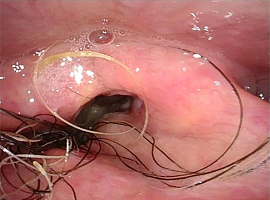Hirofumi Sei1*, Naohito Hato1 and Asami Tozawa2
1Department of Otolaryngology, Ehime University, School of Medicine, Toon-city Shitsukawa, Ehime 91-0295, Japan
2Department of Dermatology, Ehime University, School of Medicine, Toon-city Shitsukawa, Ehime 91-0295, Japan
*Corresponding author: Hirofumi Sei, Department of Otolaryngology, Ehime University, School of Medicine, Toon-city Shitsukawa, Ehime 91-0295, Japan, Tel: +81899605366; E-mail: hirofumisei@gmail.com
Received: February 12, 2021; Accepted: February 21, 2021; Published: March 25, 2021
Acknowledgment: This work was supported by the ‘Shimadzu Science Foundation’.
Citation: Hirofumi Sei, Naohito Hato, Asami Tozawa, et al. Treatment of Intractable Hair Growth After Partial Laryngectomy. Clin Image Case Rep J. 2021; 3(3): 149.


